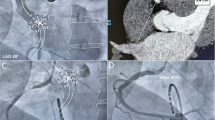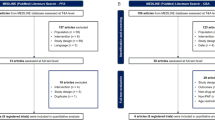Abstract
Purpose
We tested the hypothesis that electroanatomic pulmonary vein (PV) antra encircling for the PV isolation will improve the outcome in treatment of paroxysmal atrial fibrillation (PAF), compared with segmental PV isolation.
Methods
Fifty-four patients underwent segmental PV isolation (group 1) and 56 patients circumferential PV isolation (group 2) for symptomatic PAF in a randomized study.
Results
Following single ablation procedure, at the 48 ± 8 month follow-up, 30 (56%) and 32 (57%) patients in groups 1 and 2 remained free of arrhythmia (P = 0.41). After repeat ablation, 43 (80%) and 45 (80%) patients in groups 1 and 2 were free of arrhythmia without antiarrhythmic drugs (AADs); 48 (89%) and 51 (91%) patients in groups 1 and 2 did not have arrhythmia recurrences without or with AADs.
Conclusion
This study demonstrates no advantage in long-term arrhythmia-free clinical outcome after circumferential PV isolation in patients with frequent PAF.


Similar content being viewed by others
References
Haïssaguerre, M., Jaïs, P., Shah, D. C., et al. (2000). Electrophysiological endpoint for catheter ablation of atrial fibrillation initiated from multiple pulmonary venous foci. Circulation, 101, 1409–1417. Medline.
Marrouche, N. F., Dresing, T., Cole, C., et al. (2002). Circular mapping and ablation of the pulmonary vein for treatment of atrial fibrillation. Journal of the American College of Cardiology, 40, 464–474. Medline DOI 10.1016/S0735-1097(02)01972-1.
Pappone, C., Rosanio, S., Oreto, G., et al. (2000). Circumferential radiofrequency ablation of pulmonary vein ostia: a new anatomic approach for curing atrial fibrillation. Circulation, 102, 2619–2628 Medline.
Pappone, C., Oreto, G., Rosanio, S., et al. (2001). Atrial electroanatomic remodeling after circumferential radiofrequency pulmonary vein ablation: efficacy of an anatomic approach in a large cohort of patients with atrial fibrillation. Circulation, 104, 2539–2544. Medline DOI 10.1161/hc4601.098517.
Oral, H., Scharf, C., Chugh, A., et al. (2003). Catheter ablation for paroxysmal atrial fibrillation: segmental pulmonary vein ostial ablation versus left atrial ablation. Circulation, 108, 2355–2360. Medline DOI 10.1161/01.CIR.0000095796.45180.88.
Karch, M. R., Zrenner, B., Deisenhofer, I., et al. (2005). Freedom from atrial tachyarrhythmias after catheter ablation for atrial fibrillation: a randomized comparison between 2 current ablation strategies. Circulation, 111, 2875–2880. Medline DOI 10.1161/CIRCULATIONAHA.104.491530.
Mansour, M., Ruskin, J., & Keane, D. (2004). Efficacy and safety of segmental ostial versus circumferential extra-ostial pulmonary vein isolation for atrial fibrillation. Journal of Cardiovascular Electrophysiology, 15, 532–537. Medline.
Ho, S. Y., Sanchez-Quintana, D., Cabrera, J. A., & Anderson, R. H. (1999). Anatomy of the left atrium: implications for radiofrequency ablation of atrial fibrillation. Journal of Cardiovascular Electrophysiology, 10, 1525–1533. Medline DOI 10.1111/j.1540-8167.1999.tb00211.x.
Gerstenfeld, E. P., Guerra, P., Sparks, P. B., Hattori, K., & Lesh, M. D. (2001). Clinical outcome after radiofrequency catheter ablation of focal atrial fibrillation triggers. Journal Cardiovascular Electrophysiology, 12, 900–908. Medline DOI 10.1046/j.1540-8167.2001.00900.x.
Macle, L., Jaïs, P., Weerasooriya, R., et al. (2002). Irrigated-tip catheter ablation of pulmonary veins for treatment of atrial fibrillation. Journal of Cardiovascular Electrophysiology, 13, 1067–1073. Medline DOI 10.1046/j.1540-8167.2002.01067.x.
Saad, E. B., Rosillo, A., Saad, C. P., et al. (2003). Pulmonary vein stenosis after radiofrequency ablation of atrial fibrillation: functional characterization, evolution, and influence of the ablation strategy. Circulation, 108, 3102–3107. Medline DOI 10.1161/01.CIR.0000104569.96907.7F.
Pürerfellner, H., Cihal, R., Aichinger, J., Martinek, M., & Nesser, H. J. (2003). Pulmonary vein stenosis by ostial irrigated-tip ablation: incidence, time course, and prediction. Journal of Cardiovascilar Electrophysiology, 14, 158–164. Medline.
Cappato, R., Negroni, S., Pecora, D., et al. (2003). Prospective assessment of late conduction recurrence across radiofrequency lesions producing electrical disconnection at the pulmonary vein ostium in patients with atrial fibrillation. Circulation, 108, 1599–1604. Medline DOI 10.1161/01.CIR.0000091081.19465.F1.
Ouyang, F., Antz, M., Ernst, S., et al. (2005). Recovered pulmonary vein conduction as a dominant factor for recurrent atrial tachyarrhythmias after complete circular isolation of the pulmonary veins: lessons form the double Lasso technique. Circulation, 111, 127–135. Medline DOI 10.1161/01.CIR.0000151289.73085.36.
Lemola, K., Hall, B., Cheung, P., et al. (2004). Mechanisms of recurrent atrial fibrillation after pulmonary vein isolation by segmental ostial ablation. Heart Rhythm, 1, 197–202. Medline DOI 10.1016/j.hrthm.2004.03.071.
Hsieh, M. H., Tai, C. T., Tsai, C. F., et al. (2003). Clinical outcome of very late recurrence of atrial fibrillation after catheter ablation of paroxysmal atrial fibrillation. Journal of Cardiovascular Electrophysiology, 14, 598–601. Medline DOI 10.1046/j.1540-8167.2003.03047.x.
Ouyang, F., Bänsch, D., Ernst, S., et al. (2004). Complete isolation of the left atrium surrounding the pulmonary veins: new insights from the double-lasso technique in paroxysmal atrial fibrillation. Circulation, 110, 2090–2096. Medline DOI 10.1161/01.CIR.0000144459.37455.EE.
Nademanee, K., McKenzie, J., Kosar, E., et al. (2004). A new approach for catheter ablation of atrial fibrillation: mapping and the electrophysiologic substrate. Journal of the American College of Cardiology, 43, 2044–2053. Medline DOI 10.1016/j.jacc.2003.12.054.
Haïssaguerre, M., Sanders, P., Hocini, M., et al. (2005). Catheter ablation of long-lasting persistent atrial fibrillation: critical structures for termination. Journal of Cardiovascular Electrophysiology, 16, 1125–1137. Medline DOI 10.1111/j.1540-8167.2005.00307.x.
Oral, H., Chugh, A., Good, E., et al. (2007). Radiofrequency catheter ablation of chronic AF guided by complex electrograms. Circulation, 115, 2606–2612. Medline DOI 10.1161/CIRCULATIONAHA.107.691386.
Acknowledgments
This study was supported by a grant from the Czech Ministry of Health IGA MZ NA7217-3/2002.
Author information
Authors and Affiliations
Corresponding author
Rights and permissions
About this article
Cite this article
Fiala, M., Chovančík, J., Nevřalová, R. et al. Pulmonary vein isolation using segmental versus electroanatomical circumferential ablation for paroxysmal atrial fibrillation. J Interv Card Electrophysiol 22, 13–21 (2008). https://doi.org/10.1007/s10840-008-9212-7
Received:
Accepted:
Published:
Issue Date:
DOI: https://doi.org/10.1007/s10840-008-9212-7




